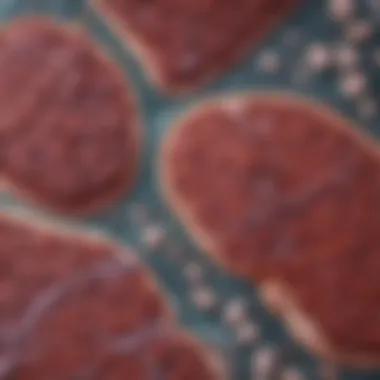Understanding Liver Enzymes and Diarrhea Connections


Intro
Understanding the link between elevated liver enzymes and diarrhea is like piecing together a puzzle, where each piece can reveal significant insights into a person’s health. Elevated liver enzymes are often flagged in routine blood tests, hinting at underlying issues with liver function. Meanwhile, diarrhea, which may often be dismissed as a mere inconvenience, can bear substantial clinical ramifications, particularly in the context of liver disease.
In clinical settings, professionals face the challenge of interpreting these symptoms collectively rather than in isolation. The complexity of the bodily systems involved raises the stakes for patients, prompting the need for a deeper exploration into the interconnections governing liver health and gastrointestinal function. By dissecting the nuances behind abnormal enzyme levels and digestive disturbances, the aim is to illuminate the pathways that lead to better diagnostic and therapeutic strategies.
Overview of Research Topic
Brief Background and Context
The liver plays a pivotal role in detoxification, metabolism, and bile production. When liver cells are damaged, enzymes such as aspartate aminotransferase (AST) and alanine aminotransferase (ALT) spill into the bloodstream. Elevated readings for these liver enzymes signal the possibility of conditions such as hepatitis, fatty liver disease, or cirrhosis. On the other hand, diarrhea represents a disruption in the gastrointestinal tract, which can stem from infections, inflammatory processes, or dietary indiscretions.
Connecting these two seemingly disparate symptoms can usher in a comprehensive understanding of health concerns. For instance, conditions like hepatitis A not only elevate liver enzymes but also often come with gastrointestinal symptoms, including diarrhea. Thus, understanding how these events correlate can unveil critical clinical insights.
Importance in Current Scientific Landscape
In today's medical landscape, the relationship between liver function and gastrointestinal symptoms warrants a reevaluation. With the rising incidence of liver diseases attributed to lifestyle factors, the prevalence of disorders leading to diarrhea is increasing as well. The urgency of this connection is underscored by a growing body of research aimed at uncovering the pathophysiology linking liver health with digestive issues.
Given that both elevated liver enzymes and diarrhea can be symptomatic of serious health issues, shedding light on their connections can improve diagnostic reflexes and ultimately advance holistic patient care.
Research suggests that integrated approaches considering both hepatic conditions and gastrointestinal symptoms may yield better outcomes.
Methodology
Research Design and Approach
This article synthesizes current literature, focusing on peer-reviewed studies, case reports, and clinical guidelines to outline the connections between elevated liver enzymes and diarrhea. A narrative review format is employed, allowing for an exploration of various etiological factors, diagnostic considerations, and management strategies.
Data Collection Techniques
Data for this article was collected from reputable medical journals, articles on platforms like Wikipedia, and databases such as PubMed. An emphasis was placed on contemporary findings to ensure relevance in today’s clinical practice. This collection method enables the integration of diverse case studies, enriching the discourse surrounding this multifaceted topic.
Prelims to Liver Function and Enzymes
The liver stands as one of the most remarkable organs in the human body, performing a myriad of functions that are vital for overall health and well-being. Understanding its operation—along with the enzymes it produces—reveals crucial insights into various medical conditions, particularly when abnormalities arise. Elevated liver enzymes often signal disruption in liver health, potentially hinting at underlying problems that can range from minor to serious.
In this section, we delve into the foundations of liver physiology and the specific enzymes associated with its function. This background lays the groundwork for comprehending the complex relationship that elevated liver enzymes have with other symptoms, including gastrointestinal disturbances like diarrhea. As elevated liver enzymes can stem from various causes—ranging from lifestyle choices, medications, and diseases—it becomes paramount to decode the nuances before addressing broader implications.
Overview of Liver Physiology
The liver, often likened to a biological processing plant, performs critical roles including detoxifying harmful substances, regulating blood sugar levels, and producing important proteins. Here are some key roles that highlight its significance:
- Metabolism: The liver metabolizes carbohydrates, fats, and proteins, helping to maintain energy levels and nutrient balance.
- Detoxification: It filters toxins from the blood, ensuring that harmful substances are efficiently broken down and excreted.
- Bile Production: The liver produces bile which is essential for digestion, especially in emulsifying fats for absorption in the intestine.
Understanding these functions helps frame the importance of monitoring liver enzymes. When these processes are disrupted, such as through liver inflammation or damage, enzyme levels can rise as a biomarker of the condition.
Understanding Liver Enzymes
Liver enzymes serve as key indicators of liver health and functionality. Among these enzymes, aminotransferases and alkaline phosphatase are among the most commonly measured. Each of these enzymes plays a role in hepatocellular function and can reflect the state of liver damage or disease. Let’s explore them in detail:
Common Liver Enzymes
- Alanine Aminotransferase (ALT): This enzyme is primarily found in the liver and its level in the blood rises when liver cells are damaged. Thus, an elevated ALT level is often one of the earliest signs of liver inflammation.
- Aspartate Aminotransferase (AST): While present in both liver and other tissues like the heart and muscles, AST can indicate liver damage when found at high levels in conjunction with elevated ALT.
- Alkaline Phosphatase (ALP): Primarily associated with bile duct function, elevated ALP can suggest issues related to bile flow, common in conditions like cholestasis or bile duct obstruction.
Each of these enzymes contributes to a comprehensive picture of liver health. However, individual enzyme levels alone do not provide a complete diagnosis; they need to be interpreted in context with other tests and clinical information.
Functions and Importance
The significance of liver enzymes goes beyond mere biomarkers. Here’s why they matter:
- Diagnostic Value: Elevated liver enzymes are instrumental for diagnosing liver conditions such as hepatitis, fatty liver disease, or cirrhosis.
- Monitoring Disease: They help track the progress of liver disease and gauge how well treatments are working, making them indispensable for ongoing care.
- Understanding Comorbidities: Often, liver health is intertwined with digestive issues, including diarrhea. Understanding enzyme levels gives insight into hepatic function that can directly affect gut health.
Knowing about these enzymes and their functionality is pivotal in drawing connections between elevated liver enzyme levels and accompanying symptoms, such as diarrhea. These enzymes' fluctuating levels can trigger a cascade of health implications and offer clues about treatment and management.
Defining Elevated Liver Enzymes
Understanding elevated liver enzymes is key in the diagnosis and management of various hepatic and gastrointestinal disorders. These enzymes, primarily alanine aminotransferase (ALT) and aspartate aminotransferase (AST), serve as important indicators of liver health. When these levels spike, they serve as a warning sign that something is amiss within the body.
Identifying the criteria for what constitutes an elevation in these enzymes is crucial for clinicians and researchers alike. The normal range for liver enzymes can vary from person to person, depending on factors like age, sex, and overall health. Moreover, elevated liver enzyme levels can indicate not only liver damage but also systemic issues that may manifest as gastrointestinal disturbances, such as diarrhea.
When looking deeper into the causes of elevated liver enzymes, we find multifaceted reasons, ranging from lifestyle choices to underlying medical conditions. By addressing these causal factors, we can better understand their implications not just for liver function but also for digestive health.
Criteria for Elevated Levels
To define elevated liver enzyme levels accurately, established reference ranges must be taken into account. Typically, ALT levels greater than 40 U/L and AST levels over 40 U/L signal abnormalities. However, elevations may be temporary and not necessarily indicative of chronic liver disease.
Regular monitoring becomes an essential part of managing liver health. Blood tests can offer immediate insights into liver function, guiding healthcare providers on the next steps.
Common Causes of Elevation
There are several prevalent factors contributing to elevated liver enzymes:
Alcohol Consumption
Alcohol consumption stands out as one of the leading causes of elevated liver enzymes. High intake can lead to alcoholic liver disease, characterized by inflammation, fatty accumulation, and, in severe cases, cirrhosis.
The key characteristic of alcohol’s role is its direct toxic effect on liver cells, culminating in elevated enzyme levels. This article emphasizes that moderation is key; however, abstaining entirely from alcohol is the best preventive strategy for liver health. This unique feature offers both immediate gratification and long-term consequences, making understanding its impact vital.


Medications
Many medications can also provoke an elevation in liver enzymes. Common offenders include non-steroidal anti-inflammatory drugs (NSAIDs), statins, and even some antibiotics.
The pressing issue with medications is that while they can provide crucial health benefits, the side effects sometimes complicate the picture. Different individuals metabolize drugs variably, leading to differing impacts on liver function. Awareness of this relationship is crucial, as it can guide prescribers in selecting safer alternatives or adjusting dosages when necessary.
Infections
Infections, particularly viral hepatitis, contribute significantly to liver enzyme elevation. The viral invasion causes hepatic cells to rupture, releasing enzymes into the bloodstream.
One notable feature of infections is their temporal effects. Although some infections may resolve without lasting damage, chronic infections can lead to formidable long-term complications. Thus, recognizing this link is essential for implementing timely interventions and preventing further damage.
Metabolic Disorders
Metabolic disorders, such as non-alcoholic fatty liver disease (NAFLD) and Wilson's disease, can frequently cause elevated enzyme levels. These conditions often go unnoticed until routine blood tests reveal abnormalities.
One key characteristic of metabolic disorders is their silent nature; they may progress without significant symptoms for years. Being aware of the connection between metabolic issues and liver enzyme elevation is essential for early diagnosis and treatment, preventing severe complications.
Understanding Diarrhea
Diarrhea is a significant topic to consider when discussing elevated liver enzymes, as it can influence both diagnostic and treatment paths for affected individuals. The relationship between the liver's functionality and gastrointestinal health is multifaceted, where disruptions in one area can lead to complications in another. By grasping the details of diarrhea—its types, causes, and overall implications—healthcare professionals can better identify potential connections to liver dysfunctions and tailor their interventions accordingly.
Types of Diarrhea
Understanding the various classifications of diarrhea provides crucial insights into its underlying mechanisms and how they might relate to elevated liver enzymes.
Acute vs Chronic
Acute diarrhea typically presents suddenly and lasts a short duration, often resolving within a couple of days. This can be particularly important when considering patients with elevated liver enzymes, as acute diarrhea can sometimes be linked to infections or food-related issues that may impact liver function. The key characteristic here is its short-lived nature.
On the other hand, chronic diarrhea persists over weeks or months. This prolonged condition can indicate serious underlying issues that might exacerbate liver conditions, ultimately complicating treatment plans. If a patient is experiencing chronic diarrhea, it might reflect long-term liver problems, possibly leading to additional diagnostic evaluations. The unique feature of chronic diarrhea is its potential to contribute to a state of malnutrition or dehydration, which might complicate recovery from liver issues.
Osmotic vs Secretory
Delving into the specifics, osmotic diarrhea occurs when substances in the intestines draw more water into the bowel, while secretory diarrhea is characterized by the intestines secreting electrolytes and fluids into the lumen. This distinction is beneficial in diagnosing potential issues related to liver functionality. For example, secretory diarrhea could arise from liver disease, affecting bile salt metabolism and leading to an imbalance in fluid regulation.
An advantage of distinguishing between these two types is that it can guide clinical assessments and management strategies. By identifying whether a patient has osmotic or secretory diarrhea, healthcare professionals can better tailor their treatment and management plans, potentially addressing the root causes that may be connected to elevated liver enzyme levels.
Common Causes of Diarrhea
Identifying common causative factors of diarrhea is fundamental in understanding its implications, particularly in relation to liver health.
Infections
Infections remain a leading cause of diarrhea worldwide, often producing symptoms swiftly. They can be viral, bacterial, or parasitic. The commonality of infections makes this an essential discussion point—because they can also lead to liver enzyme elevation. For example, viral hepatitis can trigger both gastric symptoms and liver enzyme spikes, demonstrating the intricacy of these bodily systems. Infection-associated diarrhea often means healthcare professionals must consider viral loads and hydration levels, reflecting the close ties between liver health and gastrointestinal function.
Food Intolerances
Food intolerances, although often overlooked, serve as a significant factor in the development of diarrhea. They can arise from the body's inability to digest certain substances, leading to gastrointestinal upset. These intolerances can also interact with liver function, as unresolved symptoms from undigested nutrients could exacerbate liver load, ultimately affecting enzyme levels. The advantage of identifying food intolerances lies in the potential for dietary adjustments, allowing clinicians to alleviate symptoms and improve liver function indirectly.
Medication Side Effects
Various medications can lead to diarrhea as a side effect, presenting complexities in patient management. Non-steroidal anti-inflammatory drugs (NSAIDs), antibiotics, and others can disrupt gut microbiota and promote gastrointestinal disturbances. Recognizing these medication-related issues is crucial—especially if a patient also presents with elevated liver enzymes. The unique feature here includes the potential reversible nature of these side effects once the offending medication is identified and addressed, ultimately empowering patients in their health journeys.
Link Between Elevated Liver Enzymes and Diarrhea
The relationship between elevated liver enzymes and diarrhea is not just a curious pairing; it can reveal intricate mechanisms underneath the surface of both hepatic and gastrointestinal health. When liver enzymes rise above normal ranges, they serve as signals—indicators that something is amiss. This connection warrants attention, as the interplay between liver function and digestive processes can significantly impact a person’s overall well-being.
Factors such as substance abuse, medication interference, or infections can lead to elevated enzyme levels, which may be accompanied by gastrointestinal symptoms like diarrhea. Recognizing this link can help clinicians identify underlying conditions promptly and tailor treatment strategies to address both aspects concurrently.
Moreover, understanding this connection can empower patients, helping them to make informed decisions regarding their health and seek timely medical intervention. \n
The liver's role in digestion is vital; disruption in its function can ripple through the digestive system, affecting nutrient absorption and gut health.
Pathophysiological Mechanisms
Bile Production and Excretion
Bile production and excretion is fundamental to understanding the connection between elevated liver enzymes and diarrhea. Bile, produced in the liver, aids in the digestion of fats and the absorption of fat-soluble vitamins. When liver enzymes spike, it can indicate a problem with bile synthesis or flow.
A key characteristic of bile is its emulsifying action on fats. When bile production is hindered, fats may not be properly processed—leading to malabsorption and subsequent diarrhea. This scenario presents several implications. When bile salts are not adequately excreted, they can irritate the intestines, contributing to loose stools.
The unique feature of examining bile dynamics is that it underscores the interconnectedness of the liver and gut. However, this relationship can have downsides; diagnosing issues can require comprehensive testing, which may inadvertently delay treatment. Understanding this mechanism helps to illustrate how liver function is integral to gastrointestinal health.
Impact on Gut Flora
The impact on gut flora is a significant aspect in the discussion of elevated liver enzymes and diarrhea. Liver dysfunction can disturb the delicate balance of gut microbiota. The liver metabolizes nutrients and detoxifies substances; when it fails to do so effectively, it can influence bacterial composition in the gut.
A key characteristic of gut flora is its role in digestion, metabolism, and maintaining immunity. An imbalance can promote conditions like dysbiosis, which frequently leads to digestive issues, including diarrhea. The beneficial side of recognizing the significance of gut flora is the potential for targeted interventions, such as probiotics, which can help restore equilibrium.
The challenge here lies in the effort needed to assess gut microbiota accurately. If the gut flora is affected by liver problems, rectifying this may require a focused approach that addresses both liver health and microbiome restoration. Through understanding this impact, we can appreciate the necessity of holistic treatment strategies.
Clinical Observations
Case Studies
Examining case studies sheds light on how the connection between elevated liver enzymes and diarrhea manifests in real-world scenarios. Individual cases allow healthcare professionals to observe unique patterns and outcomes that aren't always apparent in broader data sets.
These studies often highlight clinical characteristics that show direct links—such as how hepatitis can elevate liver enzyme levels alongside diarrhea caused by related factors like gut inflammation. A notable aspect of case studies is the contextual detail they provide. Each case tells a story that can inform treatment and management strategies for similar patients.


However, the limitation of case studies is their anecdotal nature. While they can offer rich insights, they may not always apply broadly and can lead to biases in understanding the bigger picture.
Epidemiological Data
Epidemiological data is crucial in examining the link between elevated liver enzymes and diarrhea on a population level. This data can reveal trends, such as the prevalence of liver conditions associated with gastrointestinal disturbances across different demographics.
A key characteristic of epidemiological studies lies in their systematic approach; they collect and analyze data to form hypotheses or conclusions about public health issues, paving the way for preventive measures and effective treatments. Understanding these patterns enables researchers and clinicians to identify potential risk factors for elevated liver enzymes that lead to diarrhea.
However, one should be cautious of the drawbacks in epidemiological data, such as confounding variables that can skew results. Still, it provides a larger context for how common this connection can be, serving as a guide for further research and clinical observation.
Through these observations, we can decipher the multifaceted relationship between elevated liver enzymes and diarrhea, shaping better clinical approaches to health management.
Diagnostic Approaches
In the quest to understand the connection between elevated liver enzymes and diarrhea, accurate diagnostic approaches play a pivotal role. They help doctors pinpoint the underlying causes, tailoring treatment options to individual needs. Recognizing that liver function directly impacts digestion and overall health opens a pathway to a comprehensive evaluation. Each diagnostic tool—whether through patient history, laboratory tests, or imaging—sheds light on different facets of liver health. This section unpacks these processes, emphasizing their importance in diagnosing and managing the intertwined symptoms of liver enzyme elevation and gastrointestinal disturbances.
Initial Evaluations
Medical History
Gathering a thorough medical history is fundamental in diagnosing liver-related issues. This aspect focuses on collecting detailed information about past illnesses, surgeries, and habits such as alcohol consumption or exposure to certain medications. One key characteristic of medical history is its ability to reveal patterns that may contribute to elevated liver enzyme levels. Physicians often find this step incredibly useful, since it provides context that lab results alone might miss.
A unique feature of medical history is that it encourages patient engagement. Patients who can articulate their symptoms, lifestyle choices, and family history empower healthcare providers to make informed decisions. However, it can be a double-edged sword as patients may inadvertently forget significant details or downplay symptoms, potentially skewing the diagnostic accuracy. Yet, engaging patients in their health journey is ultimately beneficial.
Physical Examination
The physical examination is another critical piece of the puzzle in diagnosing liver dysfunction. It allows physicians to observe any physical signs that might indicate liver disease, such as jaundice, abdominal swelling, or tenderness. The key characteristic of this method lies in its immediacy—doctors can gather essential data in real-time. This rapid assessment can guide the next steps much faster than waiting for test results.
One unique advantage of a physical examination is that it does not rely solely on patient reports. Sometimes symptoms can be obscured or misinterpreted, but a trained eye can detect the nuances in a patient’s condition. However, the limitation comes from its subjective nature; findings can vary significantly between practitioners, leading to potential inconsistencies. Still, this method remains a staple in initial evaluations, contributing significantly to the overall understanding of a patient's health.
Laboratory Tests
Liver Function Tests
Laboratory tests, specifically liver function tests (LFTs), provide crucial biochemical insights into liver health. They measure various enzymes and proteins in the blood to assess how well the liver is working. The essential feature of LFTs is their ability to quantify enzyme levels, offering a clearer picture of any elevations in liver enzymes. This precision makes them a cornerstone in the diagnostic process.
LFTs stand out because they can suggest not only liver damage but also potential effects on other organs, especially the gastrointestinal tract. However, while they offer valuable data, LFTs can sometimes present a misleading scope; liver function may appear normal in some chronic conditions, despite the presence of underlying damage. Thus, interpreting these tests requires a nuanced understanding and often needs to be paired with other diagnostic approaches.
Stool Tests
Stool tests are another key element in the diagnostic arsenal, particularly when addressing gastrointestinal symptoms like diarrhea. These tests can identify pathogens, blood, or even signs of malabsorption that might coincide with liver issues. The important aspect of stool tests is their ability to uncover gastrointestinal disturbances that might be linked to liver function.
The unique advantage of this type of test is that it can detect a variety of conditions, from infections to inflammatory disorders, providing a broader view of the patient’s health landscape. However, a downside is the stigma or discomfort some patients associate with stool testing, which may lead to lower participation rates. Nonetheless, these tests are invaluable in cases where liver health impacts digestive function, and they complement other diagnostic strategies effectively.
Imaging Studies
Ultrasound
Ultrasound imaging plays a remarkable role in evaluating liver conditions. It provides real-time images to assess liver size, structure, and blood flow. The key characteristic of ultrasound is its non-invasive nature, making it a preferred choice for preliminary investigations without exposing the patient to radiation.
One of the unique benefits of ultrasound is its ability to visualize conditions like cirrhosis or fatty liver disease early on, which can significantly inform a treatment plan. Yet, while it is beneficial, ultrasound does have limitations—it may not always detect minor issues, and results can be operator-dependent, meaning the skill and experience of the technician can influence the findings. Still, it remains a vital tool in conjunction with other diagnostic methods.
CT Scan
CT scans bring another layer of diagnostic capability, offering highly detailed images of the liver and surrounding structures. The precision of a CT scan provides a clearer view of more complex conditions that may not be easily understandable via other methods. This characteristic makes it a beneficial option when assessing severe liver diseases or when an ultrasound fails to clarify certain findings.
A unique feature of a CT scan is its ability to identify abnormalities in greater depth, allowing for comprehensive assessments of liver tumors or lesions. However, the trade-off is exposure to radiation, which makes it less ideal for routine monitoring compared to other imaging modalities. Despite this, in cases where the stakes are higher, the utility of CT scans cannot be overstated, providing critical insights necessary for clinical decision-making.
Management Strategies
Navigating the management of elevated liver enzymes and associated diarrhea requires a multi-faceted approach. The strategies often hinge on effective identification of underlying causes, as well as addressing both the liver's health and gastrointestinal functioning. Effective management is paramount for long-term health, as any oversight might escalate into more serious conditions. Here are the key areas of focus within this management framework.
Treating Elevated Liver Enzymes
Lifestyle Modifications
When it comes to managing elevated liver enzymes, lifestyle modifications can play a pivotal role. Changes in one's day-to-day habits like diet and exercise can lead to substantial improvements in liver function. For instance, reducing alcohol intake and adopting a balanced diet are essential steps. After all, there’s a saying that goes, "You are what you eat." Eating nutritious foods can help lower liver enzyme levels significantly.
One unique feature of these modifications is they often lead to holistic health benefits. Patients frequently experience improvements not only in liver health but overall well-being, including energy levels and mental clarity. Additionally, lifestyle changes empower individuals to take charge of their health. However, it is crucial to recognize that these modifications may take time and require sustained effort.
Medications
In some scenarios, medications are necessary to address elevated liver enzymes. Pharmacological interventions, such as steroid medications or specific liver-protective drugs, can assist in reducing enzyme levels effectively. This approach is essential for individuals dealing with underlying conditions like hepatitis or autoimmune liver diseases, where immediate treatment is crucial.
A standout characteristic of medication is its targeted action, able to quickly address biochemical imbalances in the liver. Yet, caution is warranted as medications can occasionally bring about unintended side effects or interact with other drugs in ways that complicate treatment. Therefore, a thorough discussion with healthcare providers is essential to weigh the pros and cons before embarking on a medication plan.
Addressing Diarrhea
Dietary Interventions
Dietary interventions are fundamental in managing diarrhea linked with elevated liver enzymes. A well-thought-out diet can alleviate gastrointestinal symptoms and contribute positively to liver health. One often recommended approach involves a high-fiber diet combined with plenty of fluids to maintain hydration, which can combat the effects of diarrhea effectively.
The versatility of dietary modifications allows for tailored solutions that meet individual needs, such as eliminating allergens or intolerant foods like lactose or gluten. Notably, incorporating probiotics can also be a unique feature that supports gut health and restores normal gut flora. However, it’s important to keep in mind that dietary changes can sometimes lead to inefficacious outcomes if not aligned correctly with the underlying cause of the liver and gastrointestinal disturbances.
Pharmacotherapy
Pharmacotherapy presents another avenue to address diarrhea, often focusing on the symptoms while aiming for underlying issues tied to elevated liver enzymes. Medications such as loperamide can reduce stool frequency and provide fast relief for acute incidents of diarrhea. This option can be particularly beneficial for patients who experience sporadic bouts of diarrhea in conjunction with liver issues.
A key characteristic of pharmacotherapy is its rapid effect, potentially leading to stark improvements in the quality of life for patients suffering acute symptoms. However, a double-edged sword exists; misuse can mask more profound problems that could be better addressed through lifestyle changes or dietary adjustments. Hence, a thorough discussion with a medical professional is encouraged to strike a balance between the two approaches.


Long-term Implications
Considering the long-term implications of elevated liver enzymes and diarrhea sheds light on the potential chronic conditions that might arise from these symptoms. It is crucial not only for patient care but also for broader public health awareness. Many individuals may take these symptoms lightly, not realizing that they could be the precursors to more serious health issues. This section delves into profound aspects that connect liver health to overall well-being, ensuring a thorough grasp of the consequences that ongoing liver issues present.
Chronic Liver Conditions
Cirrhosis
Cirrhosis represents a significant concern in the context of chronic liver health. This condition is characterized by the progressive replacement of healthy liver tissue with scar tissue, which disrupts liver function. Highlighting its profound impact emphasizes why it's discussed here. Cirrhosis often manifests as a consequence of prolonged exposure to harmful substances, such as alcohol or viruses. This scarring process can lead to increased pressures in the portal vein, potentially causing gastroesophageal varices and subsequent hemorrhage.
Unique features of cirrhosis include its ability to remain asymptomatic until advanced stages, complicating early detection. While this might be disadvantageous for the patient, it also serves to illustrate how ongoing monitoring of liver enzyme levels can provide critical insights into one's health trajectory. Being aware of this condition fosters a heightened sense of vigilance among both patients and providers, promoting early intervention strategies that may enhance life quality.
Hepatitis
Moving on to Hepatitis, it offers another layer to the conversation around chronic liver conditions. Hepatitis refers to inflammation of the liver, often caused by viral infections, alcohol abuse, or autoimmune diseases. Its key characteristic lies in the diverse range of Hepatitis types, such as A, B, C, D, and E, which leads to distinct management strategies and implications for patient outcomes.
For this article, understanding Hepatitis is beneficial because its potential progression to chronic liver disease can significantly influence liver enzyme levels, paving way for dire consequences if untreated. A unique aspect of Hepatitis is its varying degrees of transmissibility and severity. Knowing these factors can aid in tailoring preventive measures, and treatment options, thus guiding patient education and healthcare directives.
Gastrointestinal Health
Impact of Chronic Conditions
The impact of chronic liver conditions extends beyond liver functionality; they also profoundly affect gastrointestinal health. Many don’t realize how intertwined liver function and gut health are. A failing liver can lead to improper digestion, nutrient malabsorption, and even gut dysbiosis, contributing to diarrhea and other issues.
This key characteristic showcases the critical need for a holistic approach when evaluating patients with liver dysfunction. Strategies for management should incorporate both liver health and gastrointestinal wellness, ensuring that practitioners address the whole picture rather than the isolated symptoms. Recognizing this connection can also aid in educating patients about the broader implications of their liver health on daily life and overall well-being.
Preventive Care
Preventive care is an essential facet in any discussion regarding health, particularly in contexts involving chronic liver diseases. Emphasizing prevention as a strategy underscores the role that regular monitoring and lifestyle modifications can play in mitigating disease progression. The significance lies in its immediacy; early interventions could be achieved through simple changes in diet, exercise, and regular screenings.
A unique feature of preventive care in this context is its capability to not merely focus on treatment but to promote overall health. This proactive stance encourages patients to take charge of their health, sparking an awareness that can lead to timely medical consultations and lifestyle adjustments. The benefits of preventive care extend to cost savings for healthcare systems as well, as early intervention typically reduces the need for more aggressive treatments down the line.
It is pivotal for both healthcare providers and patients to acknowledge the long-term implications of elevated liver enzymes and diarrhea, as such awareness can lead to improved management and healthier outcomes.
Future Research Directions
The exploration of elevated liver enzymes and diarrhea is far from exhaustive. It beckons for further investigation and novel approaches. Future research is paramount for several reasons. It not only helps unravel the intricate biological interactions at play but also aids in forming comprehensive treatment strategies. By diving deeper into this subject, researchers can create tailored interventions that will benefit both patients and healthcare providers alike.
Emerging Insights
Microbiome Studies
The gut microbiome has become a buzzword in recent medical research, and for good reason. Microbiome studies focus on the dense community of microorganisms residing in our intestines. They play a crucial role in digestion, metabolism, and even immune function. In the context of elevated liver enzymes and diarrhea, researchers are keenly looking at how these microorganisms can influence liver health.
One key characteristic of microbiome studies is their ability to highlight individual variability. Each person's gut microbiome is as unique as a fingerprint, which means that the way one individual reacts to liver dysfunction may differ greatly from another. This variability makes such studies a beneficial avenue for understanding the broader implications of liver enzyme changes and gastrointestinal disturbances.
Moreover, microbiome studies provide unique insights into the way liver function affects gut flora and vice versa. The advantages are clear: potential for personalized treatment strategies. On the downside, the complexity of the microbiome makes it difficult to establish straightforward cause-and-effect relationships, which can be frustrating for researchers.
Genetic Factors
Genetic factors are another critical puzzle piece in the elevated liver enzymes and diarrhea narrative. The connection between genetic predispositions and liver function is well established; certain genetic markers can indicate a higher risk of liver diseases. Understanding these genetic factors could pave the way for better predictive models regarding liver health and its impact on gut functionality.
A key characteristic of studying genetic factors is the identification of heritable conditions that can predispose individuals to liver problems or gastrointestinal disorders. This genetic insight can be instrumental in informing early interventions or preventive care strategies. Since this approach has been gaining traction, it holds promise as a beneficial exploration for the article.
The unique feature of focusing on genetic factors is its potential to point out inherited traits that may lead to chronic liver issues. However, researchers must navigate the challenge that not all genetic predispositions express with the same intensity in every individual, making it a complex terrain to explore.
Clinical Trials
Novel Therapeutics
Novel therapeutics present a captivating frontier in the realm of treating elevated liver enzymes and diarrhea. As new drugs and treatment methods emerge, they offer fresh hope for managing conditions that have so far been resistant to conventional therapies. The appeal of novel therapeutics lies in their capacity to address underlying issues rather than merely alleviating symptoms.
These therapies, often derived from cutting-edge research, can target specific pathways involved in liver function decline or gut health disturbances. Their key characteristic is their innovative nature, often providing solutions that are less invasive and have fewer side effects than traditional treatment methods. This aspect makes them worth considering for any clinical discourse about liver health.
Unique to novel therapeutics is their adaptability in clinical settings. They can be tailored to meet the specific needs of different patient populations, enhancing the likelihood of successful outcomes. However, on the flip side, the high costs associated with drug development can pose challenges, and not every new therapy will gain FDA approval.
Dietary Modifications
Dietary modifications offer a holistic approach to managing both elevated liver enzymes and diarrhea. Nutrition plays an undeniable role in liver function and gastrointestinal health. Research increasingly suggests that specific dietary adjustments can significantly affect enzyme levels and overall gut health.
One key characteristic of dietary modifications is their accessibility. Unlike pharmaceuticals, adjusting one’s diet doesn’t usually require a prescription, making it a popular choice for individuals looking for manageable changes. Moreover, proper nutritional intervention can support liver function while addressing the symptoms of diarrhea.
Dietary modifications can range from increasing fiber intake to eliminating certain irritants like gluten or lactose, based on individual tolerance levels. The unique feature here is the synergistic effect of diet on both liver and gut health. However, one must consider that dietary changes can be challenging for some, and not everyone will experience the same results, which adds another layer of complexity to this field.
Finale
In exploring the connections between elevated liver enzymes and diarrhea, this article sheds light on a topic that is crucial for both medical professionals and patients. Understanding how liver function affects gastrointestinal health allows health care providers to form a more comprehensive picture of a patient's overall health. Recognizing these relationships can lead to timely interventions and better management strategies, ultimately improving patient outcomes.
Summary of Key Points
To encapsulate the discussions throughout the article, several key points emerge:
- Elevated liver enzymes can arise from diverse etiological factors, including medications and lifestyle choices.
- Diarrhea presents a multifaceted challenge, with its own range of causes and types, each requiring tailored approaches for effective management.
- There exists a recognizable link between liver dysfunction and gastrointestinal disturbances, highlighting the need for an integrated diagnostic approach.
- Management strategies must consider both liver health and gastrointestinal symptoms to ensure a holistic treatment plan.
By succinctly grasping these points, readers can appreciate the interconnectedness of liver and digestive health, ultimately leading to well-informed decisions regarding treatment plans.
Importance of Comprehensive Evaluation
A thorough evaluation is paramount when addressing elevated liver enzymes and associated diarrhea. This process should include:
- Detailed Medical History: Collecting information on lifestyle, diet, medication use, and family history can uncover potential risk factors.
- Physical Examination: Conducting a complete physical assessment helps to identify any observable signs related to liver or gastrointestinal issues.
- Interdisciplinary Approach: Involving specialists from various fields allows for a multi-angle assessment, leading to a more accurate diagnosis.
Comprehensive evaluation not only aids in establishing a precise diagnosis but also serves as a foundation for effective treatment strategies. Ignoring the connections between these systems can lead to misdiagnosis or delayed treatment, making a thorough evaluation indispensable in clinical practice. In short, understanding the full scope of symptoms and their potential interrelations is vital for achieving optimal patient care.
"A stitch in time saves nine"—addressing issues promptly can lead to less complicated health scenarios down the line.



